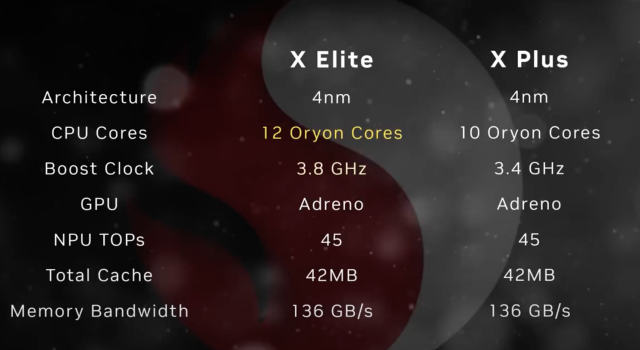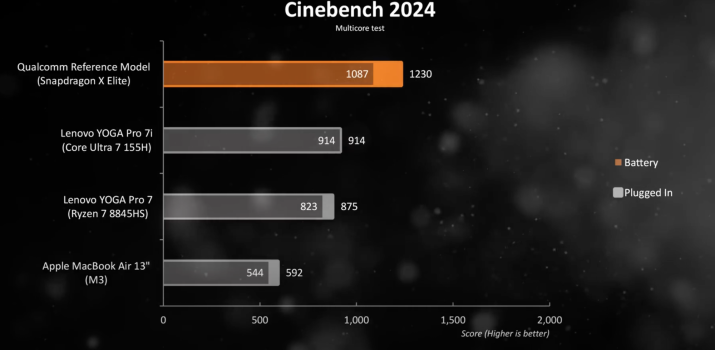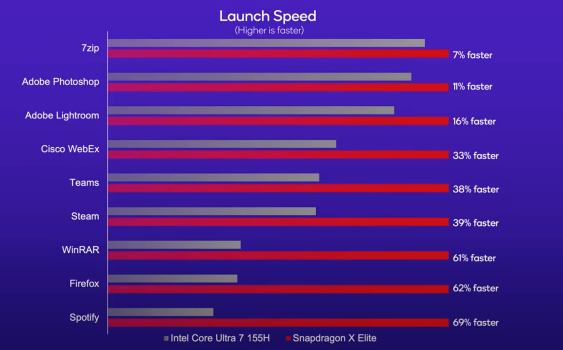It's not just Demerjian, here from AnandTech:
"Heading up the chip stack is the fastest, fully-enabled Snapdragon X Elite chip, the X1E-84-100.
./.
Compared to their October demos, however, there are a couple of important points to point out – areas where the chip specs have been downgraded. First and foremost, the peak dual core clockspeed on the chip (what Qualcomm calls Dual Core Boost) will only be 4.2GHz, instead of the 4.3GHz clockspeeds we saw in Qualcomm’s early demos. The LPDDR5X memory frequency has also taken an odd hit, with this chip topping out at LPDDR5X-8448, rather than the LPDDR5X-8533 data rate we saw last year. This is all of 85MHz or 1GB/second of memory bandwidth, but it’s an unexpected shift since 8448 isn’t a normal LPDDR5X speed grade.
Qualcomm has not offered any explanation for the lowered specifications. I can only presume that they’ve had a harder time yielding chips with CPU cores that can hit 4.3GHz than the company was initially expecting, especially looking at the rest of the chip stack."
Don't know if both reports are hitting on related issues or not.
I suspect largely different issues. Trying to roll out a new platform via multiple vendors on bleeding edge LPDDR5X isn't going to lower system costs if have 4-5 system vendors get into a bidding war on limited supply. ( is Qualcomm sells multiple chip packages with the RAM already soldered onto that 'board' or just the main SoC chip package ? Whenever Qualcomm shows it in their presentation it is just the SoC. Anandtech article ... snapshot of just a chip package. ). Likewise if 2-3 vendors do supply hoarding the other competitors can ship as much competition.
Does LPDDR5-8448 let more suppliers into the solution set? Pragmatically a 'first iteration' so there is likely some substantial guessing going on for the supply/demand balance. It probably wouldn't take much to throw that off if folks are skittish on some competitive advantage if 'miss out'.
X Elite ship date has flopped around a lot over the last 2+ years. That probably isn't helping line up supply and demand much either.
Intel Ultra (Meteor Lake ) is only 7467
Intel® Core™ Ultra 9 Processor 185H (24M Cache, up to 5.10 GHz) quick reference with specifications, features, and technologies.

ark.intel.com
About the same for AMD 8040 series ~7500 . Some rumors put AMD strix point at LPDDR5X 8500 ( which is higher but also less than 8533 ). If Strix Point comes in sub 8500 also from same system vendors there is a chance it could be a common supply pool issue. ( at least in 2024).
As for the Semiaccurate issue with System vendors not seeing the same results. It appears several vendors are just throwing same chassis at the Qualcomm SoC. How vendors this is their first time PC Qualcomm board after XX years doing Intel models. Intel spends lots of effort 'handing hands' and 'triaging' issue for folks in the design phase. It has taken AMD years to get more traction in laptop space, in part because it was 'easier' to do stable Intel versions
Given there are more system vendors doing a Qualcomm based product this time ( and far more variations being shipped) there is a decent chance that 1-2 systems will be stinkers (or at least have hiccups). Everyone getting it 100% right on the first try ... really?
Apple has a relatively very narrow range of products to spend more time on fewer products. Heck, most years some Mac usually gets completely left out of the update rotation. Apple doesn't even do the whole product line consistently. This is going to be 4-9x as many different systems than Apple will ship this year. Coordinating and herding 'all of the cats' is skill that Qualcomm really had to do at this level in this space before.
Has Qualcomm or a System vendor dropped the ball somewhere on this path? Probably. Charlie has a tendacy of finding a few folks who are complaining and turning it into a drama festival.
That said, I think Qualcomm has probably overplayed the "better than M-series" hype card too much. They really primarily need to beat Intel and trade more blows with AMD (GPU wise they aren't going to 'win' at the top end.).
However, it is also lots harder for them to displace x86-64 in super hard core system vendors. They needed a "fear of missing out" vibe to get a bigger critical mass of vendors on board. if they shoot at trying to get 7 vendors on board with decent SoC buying flow and only get 5 it still likely would be a 'win'. That's better than what they had before. Just move on to a better rollout for X2E/X2P. Nothing miraculous is going to happen "over night".






